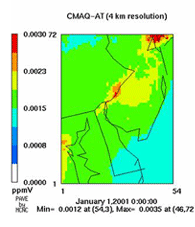Air Toxics Modeling
Research Programs
The Clean Air Act of 1990 identified 188 individual compounds or mixtures of compounds as hazardous air pollutants (HAPs) that have the potential for causing adverse health effects, such as cancer, reproductive and neurological effects, immune system damage and birth defects. Toxics that are released into the atmosphere can disperse across the country and be inhaled, or can be deposited to land and soil, where they may be ingested directly by humans or taken up by plants or animals which are then consumed by humans and animals.
Air quality models that can predict the ambient concentrations and deposition of these toxic compounds are needed so that we can assess the degree to which humans and ecosystems are exposed to these compounds. To obtain accurate estimates of the ambient concentrations of these compounds, the important processes that control their fate must be properly accounted for. Since each compound, or mixture of compounds, has unique physical and chemical properties that affect the relative importance of those processes, each compound must be considered individually. The objective of this work is to develop models that can describe the chemical and physical processes affecting concentrations of toxic air pollutants in the atmosphere, at spatial scales, ranging from < 1 to 36 km. In this task, we are extending the capabilities of EPA's Community Multiscale Air Quality (CMAQ) model, and applying this model to study high-priority issues related to toxic air pollutants. With these improvements, CMAQ will be able to handle the wide variety of processes that toxic air pollutants are subjected to, including gas and aqueous phase photochemistry, heterogeneous chemistry, transport, deposition, and re-emission from the surface.
Air Toxics
CMAQ Model Extensions to New SpeciesApplications of Toxic Air Pollutant Modeling: the National Air Toxics Assessment
Philadelphia modeling in collaboration with Region 3
Develop Linkages to Advanced Human Exposure Models
Hybrid Modeling Approaches
Fine-scale CMAQ simulations & urban canopy parameterizations
Modeling Subgrid Concentration Variability
One area of research performed under this task includes the extension of chemical mechanisms so that CMAQ can be used predict the concentrations of toxic chemicals that are not available in standard chemical mechanisms, and the application of these models at both national and urban scales, with concentration information provided to human exposure models.
The second critical area of this research is the development of methods that can be used to apply these models at more finely-resolved scales, so that we can predict hot spots in toxic concentrations and the environmental variability of exposure to air toxics. A near-term project involves investigating ways that we can incorporate information from Gaussian plume models with Eulerian models in a hybrid modeling approach. Longer-term research work is being performed and demonstrated in order to model toxic air pollutant concentrations at very fine, “neighborhood” scales, accounting for the effects of urban canopies, as well as to account for subgrid-scale concentrations (link to sidebar topic G) within the CMAQ model in a mass-consistent manner.
This task is closely linked to other tasks within the Atmospheric Sciences Modeling Division that involve the development and evaluation of the modeling system, as well as improvements in chemical and physical characterization of air toxics, and the measurement of ambient air toxics concentrations.
More background information on EPA’s Air Toxics program can be found here.
![[logo] US EPA](https://webarchive.library.unt.edu/eot2008/20081009161134im_/http://www.epa.gov/epafiles/images/logo_epaseal.gif)
